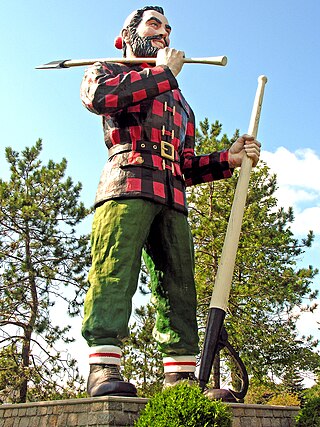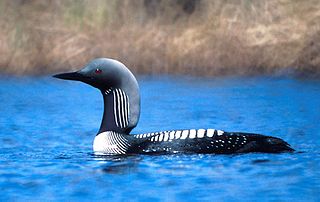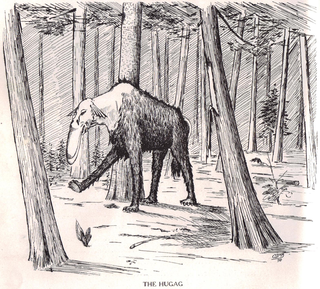Related Research Articles

Paul Bunyan is a giant lumberjack and folk hero in American and Canadian folklore. His tall tales revolve around his superhuman labors, and he is customarily accompanied by Babe the Blue Ox, his pet and working animal. The character originated in the oral tradition of North American loggers, and was later popularized by freelance writer William B. Laughead (1882–1958) in a 1916 promotional pamphlet for the Red River Lumber Company. He has been the subject of various literary compositions, musical pieces, commercial works, and theatrical productions. His likeness is displayed in a number of oversized statues across North America.

In American folklore, a Sidehill gouger is a fearsome critter adapted to living on hillsides by having legs on one side of their body shorter than the legs on the opposite side, having evolved to resemble any form of mammals such as pangolins, goats, humans, and bears. This peculiarity allows them to walk on steep hillsides, although only in one direction; when lured or chased into the plain, they are trapped in an endless circular path. Some claim these creatures play a large role in, and in some cases are responsible for, the creation of hoodoos. The creature is variously known as the Sidehill Dodger, Sidehill Hoofer, Side-hill Gazink, Sidehill Ousel, Sidehill Loper, Sidehill Galoot, Gyascutus, Sidewinder, Wampus, Boofum, Gudaphro, Hunkus, Rickaboo Racker, Prock, Gwinter, or Cutter Cuss.

The common loon or great northern diver is a large member of the loon, or diver, family of birds. Breeding adults have a plumage that includes a broad black head and neck with a greenish, purplish, or bluish sheen, blackish or blackish-grey upperparts, and pure white underparts except some black on the undertail coverts and vent. Non-breeding adults are brownish with a dark neck and head marked with dark grey-brown. Their upperparts are dark brownish-grey with an unclear pattern of squares on the shoulders, and the underparts, lower face, chin, and throat are whitish. The sexes look alike, though males are significantly heavier than females. During the breeding season, loons live on lakes and other waterways in Canada; the northern United States ; and southern parts of Greenland and Iceland. Small numbers breed on Svalbard and sporadically elsewhere in Arctic Eurasia. Common loons winter on both coasts of the US as far south as Mexico, and on the Atlantic coast of Europe.

The black-throated loon, also known as the Arctic loon and the black-throated diver, is a migratory aquatic bird found in the northern hemisphere, primarily breeding in freshwater lakes in northern Europe and Asia. It winters along sheltered, ice-free coasts of the north-east Atlantic Ocean and the eastern and western Pacific Ocean. This loon was first described by Carl Linnaeus in 1758 and has two subspecies. It was previously considered to be the same species as the Pacific loon, of which it is traditionally considered to be a sister species, although this is debated. In a study that used mitochondrial and nuclear intron DNA, the black-throated loon was found to be sister to a clade consisting of the Pacific loon and two sister species, the common loon and the yellow-billed loon.

The Pacific loon or Pacific diver, is a medium-sized member of the loon, or diver, family.

The red-throated loon or red-throated diver is a migratory aquatic bird found in the northern hemisphere. The most widely distributed member of the loon or diver family, it breeds primarily in Arctic regions, and winters in northern coastal waters. Ranging from 55 to 67 centimetres in length, the red-throated loon is the smallest and lightest of the world's loons. In winter, it is a nondescript bird, greyish above fading to white below. During the breeding season, it acquires the distinctive reddish throat patch which is the basis for its common name. Fish form the bulk of its diet, though amphibians, invertebrates, and plant material are sometimes eaten as well. A monogamous species, red-throated loons form long-term pair bonds. Both members of the pair help to build the nest, incubate the eggs, and feed the hatched young.

The hooded crow, also called the scald-crow or hoodie, is a Eurasian bird species in the genus Corvus. Widely distributed, it is found across Northern, Eastern, and Southeastern Europe, as well as parts of the Middle East. It is an ashy grey bird with black head, throat, wings, tail, and thigh feathers, as well as a black bill, eyes, and feet. Like other corvids, it is an omnivorous and opportunistic forager and feeder.
Finnish mythology commonly refers of the folklore of Finnish paganism, of which a modern revival is practiced by a small percentage of the Finnish people. It has many shared features with Estonian and other Finnic mythologies, but also with neighbouring Baltic, Slavic and, to a lesser extent, Norse mythologies.

The black-headed gull is a small gull that breeds in much of the Palearctic including Europe and also in coastal eastern Canada. Most of the population is migratory and winters further south, but some birds reside in the milder westernmost areas of Europe. The species also occurs in smaller numbers in northeastern North America, where it was formerly known as the common black-headed gull.

The Canada jay, also known as the gray jay, grey jay, camp robber, or whisky jack, is a passerine bird of the family Corvidae. It is found in boreal forests of North America north to the tree line, and in the Rocky Mountains subalpine zone south to New Mexico and Arizona. A fairly large songbird, the Canada jay has pale grey underparts, darker grey upperparts, and a grey-white head with a darker grey nape. It is one of three members of the genus Perisoreus, a genus more closely related to the magpie genus Cyanopica than to other birds known as jays. The Canada jay itself has nine recognized subspecies.

The fulvous whistling duck or fulvous tree duck is a species of whistling duck that breeds across the world's tropical regions in much of Mexico and South America, the West Indies, the southern United States, sub-Saharan Africa and the Indian subcontinent. It has plumage that is mainly reddish brown, long legs and a long grey bill, and shows a distinctive white band across its black tail in flight. Like other members of its ancient lineage, it has a whistling call which is given in flight or on the ground. Its preferred habitat consists of wetlands with plentiful vegetation, including shallow lakes and paddy fields. The nest, built from plant material and unlined, is placed among dense vegetation or in a tree hole. The typical clutch is around ten whitish eggs. The breeding adults, which pair for life, take turns to incubate, and the eggs hatch in 24–29 days. The downy grey ducklings leave the nest within a day or so of hatching, but the parents continue to protect them until they fledge around nine weeks later.

The neotropic cormorant or olivaceous cormorant is a medium-sized cormorant found throughout the American tropics and subtropics, from the middle Rio Grande and the Gulf and Californian coasts of the United States south through Mexico and Central America to southern South America, where it is called by the indigenous name of biguá. It also breeds in the Bahamas, Cuba, and Trinidad. It can be found both on coasts and in inland waters. There are at least two subspecies: N. b. mexicanum from Nicaragua northwards and N. b. brasilianum further south. In Peru, the neotropic cormorant is used by the Uru people for fishing.

The yellow-rumped cacique is a passerine bird in the New World family Icteridae. It breeds in much of northern South America from Panama and Trinidad south to Peru, Bolivia and central Brazil. However, they have been sighted as far north as Nayarit state in Mexico.

Albatrosses, of the biological family Diomedeidae, are large seabirds related to the procellariids, storm petrels, and diving petrels in the order Procellariiformes. They range widely in the Southern Ocean and the North Pacific. They are absent from the North Atlantic, although fossil remains show they once occurred there and occasional vagrants are found. Albatrosses are among the largest of flying birds, and species of the genus Diomedea have the longest wingspans of any extant birds, reaching up to 3.7 m (12 ft). The albatrosses are usually regarded as falling into four genera, but disagreement exists over the number of species.

In North American folklore and American mythology fearsome critters were tall tale animals jokingly said to inhabit the wilderness in or around logging camps, especially in the Great Lakes region. Today, the term may also be applied to similar fabulous beasts.

The Tasmanian wedge-tailed eagle is an endangered bird of Tasmania. It is a subspecies of the more common wedge-tailed eagle.

The collared sparrowhawk is a small, slim bird of prey in the family Accipitridae found in Australia, New Guinea and nearby smaller islands. As its name implies the collared sparrowhawk is a specialist in hunting small birds. It is characterised by its slight brow ridges and slender feet. The last segment of their middle toe projects beyond the claws of the other toes.

Brazza's martin is a passerine bird in the swallow family, Hirundinidae. It is 12 centimeters (4.7 in) long with grey-brown upperparts, heavily black-streaked white underparts, and a brownish tint to the breast plumage. The sexes are similar, but juvenile birds have more diffuse breast streaking and reddish-brown edges to the feathers of the back and wings. The song consists of a series of short notes of increasing frequency, followed by a complex buzz that is sometimes completed by a number of clicks.

The Fatu-liva is a fictional species of bird invented by George S. Chappell in his travel parody The Cruise of the Kawa: Wanderings in the South Seas, by Walter E. Traprock (1921). Fatu-liva were said to be found only in the fictional "Filbert Islands" in the South Pacific Ocean where they laid cube-like, black-spotted eggs that were very similar in appearance to dice. The bird's nest was described in the book as:
"...a semi-spheric bowl of closely woven grass in which lay four snow-white, polka-dotted cubes, the marvelous square eggs of the fatu-liva."
In American folklore, the snow snake is a fearsome critter that, unlike other reptiles, can live in cold temperatures and is only active during winter months.
References
- 1 2 Brown, Charles (1935). Paul Bunyan Natural History. C.E. Brown. p. 6.
- ↑ Borges, Jorge; Guerro, Margaritta; Thomas di Giovanni, Norman (1969). The Book of Imaginary Beings. The Hearst Corporation. p. 107.
- ↑ Scribner, Frank; Mayo, Earl (1899). In The Land of the Loon. F. Tennyson Neelyn. pp. 181–185.
- ↑ Junior Class (1899). "The Echo of the Seneca". 37. Hobart College: 94.
{{cite journal}}: Cite journal requires|journal=(help) - ↑ Rockwell, J. E. (February 1910). "Some Lumberjack Myths". The Outer's Book. pp. 157–160.
- ↑ Traprock, Walter (1921). The Cruise of Kawa Wandering in the South Seas. G.P. Putman's Sons. pp. 83–84, 124, 130.